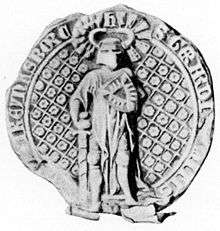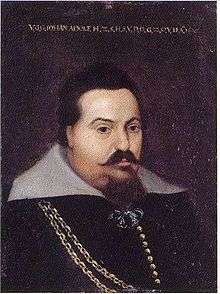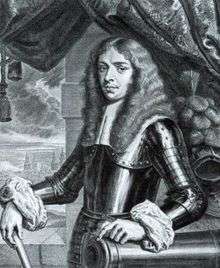The following is a list of rulers, usually dukes, who ruled both Schleswig and Holstein, starting from the first Holstein count who received Schleswig, until both provinces were annexed by the Kingdom of Prussia; and afterwards, titular dukes.
In the course of history the County of Holstein was several times partitioned among the inheriting sons into up to six lines. In 1386 King Oluf II of Denmark and his mother-regent, Queen Margaret I, enfeoffed in Nyborg Gerhard VI, Count of Holstein-Rendsborg and his cognatic successors with the Duchy of Schleswig.[1] He was as Gerhard II duke of Schleswig. Until 1390 the Rendsborg branch united by inheritance all branches except of that of Holstein-Pinneberg. It remaining a separately ruled territory in Holstein until its line was extinct in 1640, when Holstein-Pinneberg was merged into the then Duchy of Holstein. Furthermore, the here mentioned rulers of course only reigned Holstein and Schleswig in their respective territorial composition of the time, thus without states and territories only merged later in what became today's State of Schleswig-Holstein, such as Ditmarsh, conquered and annexed in 1559, Saxe-Lauenburg merged in 1876, Heligoland (British rule 1807–1891), Free and Hanseatic City of Lübeck, Region of Lübeck, together with some Hamburgian exclaves in 1937. In turn much of the current westerly, northerly and easterly suburbs within Greater Hamburg were ceded from Holstein on 1 April 1937 (Cf. Greater Hamburg Act). North Schleswig had merged into Denmark in 1920. Some Lauenburgian and Mecklenburgian municipalities were exchanged by the Barber Lyashchenko Agreement in 1945.
The House of Oldenburg ruling Schleswig, and ruling Holstein besides the House of Schauenburg
Christian I inherited the Duchy of Schleswig, a Danish fief, and the County of Holstein-Rendsburg, a Saxe-Lauenburgian subfief within the Holy Roman Empire, following the death of his maternal uncle Adolf I (and VIII as Count of Holstein-Rendsburg). In 1474 Lauenburg's liege lord Emperor Frederick III elevated Christian as Count of Holstein-Rendsburg to Duke of Holstein, thus becoming an immediate imperial vassal (see imperial immediacy). The smaller Holstein-Pinneberg remained a county further ruled by the House of Schauenburg.
|
|
House of Oldenburg (1460–1544)
| Joint rule in the Duchy of Schleswig and the County of Holstein-Rendsburg (= Duchy of Holstein as of 1474).
|
| Portrait
| Reign
| Name
|
|
| 1460–1481
| Christian I (Christian 1.), elevated to Duke of Holstein by Emperor Frederick III in 1474
|
|
| 1481–1513
| John I (Hans), with Frederick I since 1482
|
|
| 1513–1523
| Christian II (Christian 2.), deposed, died 1559; with Frederick I
|
|
| 1490–1533
| Frederick I (Frederik 1.), as administrator 1482–1490, thereafter co-ruling
|
|
| 1523–1544
| Christian III (Christian 3.), with his father until 1533
|
|
House of Schauenburg (1460–1544)
| Joint rule in the Counties of Holstein-Pinneberg and of Schaumburg.
|
| Image
| Reign
| Name
|
|
| 1426–1464
| Otto II
|
|
| 1464–1474
|
Adolphus X
|
|
| 1474–1492
|
Eric
|
|
| 1492–1510
| Otto III
|
|
| 1510–1526
|
Anthony
|
|
| 1492–1510
|
John IV
|
|
| 1527–1531
|
Jobst I
|
|
| 1531–
1560
|
John V
| |
The Houses of Oldenburg, Gottorp, Haderslev, and Schaumberg ruling in Holstein and Schleswig
The House of Schauenburg (Schaumburg) continued its rule only in the County of Holstein-Pinneberg. Independent of that county Christian III ruled the entire Duchies of Holstein and of Schleswig also in the name of his then still minor half-brothers John II the Elder and Adolf between 1533 and 1544. In 1544 they partitioned the Duchies of Holstein (a fief of the Holy Roman Empire) and of Schleswig (a Danish fief) in an unusual way, following negotiations between the brothers and the Estates of the Realm of the duchies, which opposed a factual partition. They determined their youngest brother Frederick for a career as Lutheran administrator of an ecclesiastical state within the Holy Roman Empire.[2]
So the revenues of the duchies were divided in three equal shares by assigning the revenues of particular areas and landed estates to each of the elder brothers, while other general revenues, such as taxes from towns and customs dues, were levied together but then shared among the brothers. The estates, whose revenues were assigned to the parties, made Holstein and Schleswig look like patchwork rags, technically inhibiting the emergence of separate new duchies, as intended by the estates of the duchies. The secular rule in the fiscally divided duchies thus became a condominium of the parties. As dukes of Holstein and Schleswig the rulers of both houses bore the formal title of "Duke of Schleswig, Holstein, Dithmarschen and Stormarn".
The dynastic name Holstein-Gottorp comes as convenient usage from the technically more correct Duke of Schleswig and Holstein at Gottorp. Adolf, the third son of Duke and King Frederick I and the second youngest half-brother of King Christian III, founded the dynastic branch called House of Holstein-Gottorp, which is a cadet branch of the then royal Danish House of Oldenburg. The Danish monarchs and the Dukes of Holstein-Gottorp listed below ruled both duchies together as to general government, however, collected their revenues in their separate estates. John II the Elder conveniently called Duke of Schleswig-Holstein-Haderslev produced no issue, so no branch emerged from his side.
Similar to the above-mentioned agreement Christian III's youngest son John the Younger gained for him and his heirs a share in Holstein's and Schleswig's revenues in 1564, comprising a third of the royal share, thus a ninth of Holstein and Schleswig as to the fiscal point of view. John the Younger and his heirs, however, had no share in the condominial rule, they were only titular partitioned-off dukes.
The share of John II the Elder, who died in 1580, was halved between Adolf and Frederick II, thus increasing again the royal share by a fiscal sixth of Holstein and Schleswig.[3] As an effect the complicated fiscal division of both separate duchies, Holstein and Schleswig, with shares of each party scattered in both duchies, provided them with a condominial government binding both together, partially superseding their legally different affiliation as Holy Roman and Danish fiefs.
|
|
|
|
House of Oldenburg (1544–1580)
Condominial rule in the Duchies of Holstein and of Schleswig.
|
| Portrait
| Reign
| Name
|
|
| 1523–
1559
| Christian III – with his brothers Adolf and John II
|
|
| 1559–
1588
| Frederick II (Frederik 2.)
| |
House of Schleswig-Holstein-Haderslev
Condominial rule in the Duchies of Holstein and of Schleswig.
|
| Portrait
| Reign
| Name
|
|
| 1544–
1580
| John II the Elder – with his brothers Adolf and Christian, and then the latter's son Frederick.
|
| In 1580 Frederick II and Adolf halved John's share among each other.
| |
House of Schleswig-Holstein-Gottorp (1544–80)
Condominial rule in the Duchies of Holstein and of Schleswig.
|
| Portrait
| Reign
| Name
|
|
| 1544–
1586
| Adolf – with his brothers John II and Christian and then the latter's son Danish Frederick II
| |
House of Schauenburg (1544–80)
| Joint rule in the Counties of Holstein-Pinneberg and of Schaumburg.
|
| Image
| Reign
| Name
|
|
| 1531–
1560
| John V – with Otto IV since 1544
|
|
| 1544–
1576
| Otto IV – till 1560 with his brother John V
|
|
| 1576–
1601
| Adolphus XI
| |
|
|
|
House of Oldenburg (1580–1640)
| Condominial rule in the Duchies of Holstein and of Schleswig.
|
| Portrait
| Reign
| Name
|
|
| 1559–1588
| Frederick II (Frederik 2.)
|
|
| 1588–1648
|
Christian IV – He acquired Holstein-Pinneberg and merged it with his share of Ducal Holstein in 1640
| |
House of Schleswig-Holstein-Gottorp (1580–1640) |
House of Schauenburg (1580–1640)
| Joint rule in the Counties of Holstein-Pinneberg and of Schaumburg.
|
| Portrait
| Reign
| Name
|
|
| 1576–1601
| Adolphus XI
|
|
| 1601–1622
| Ernest – elevated to Prince of Schaumburg in 1619
|
|
| 1622–1635
| Jobst Hermann
|
|
| 1635–1640
| Otto V
|
| With Otto's death the main line of Schauenburg was extinct and Holstein-Pinneberg was acquired by Christian IV for the royal share of the Holstein duchy.
| |
|
|
House of Oldenburg (1640–1713)
| Condominial rule in the Duchies of Holstein and of Schleswig.
|
| Portrait
| Reign
| Name
|
|
| 1588–1648
| Christian IV
|
|
| 1648–1670
| Frederick III (Frederik 3.)
|
|
| 1670–1699
| Christian V (Christian 5.)
|
|
|
1699–1730
|
Frederick IV (Frederik 4.)
|
| In 1713 Frederick IV united all of Schleswig/Sønderjylland in one hand.
| |
House of Schleswig-Holstein-Gottorp (1640–1713)
| Condominial rule in the Duchies of Holstein and of Schleswig.
|
| Portrait
| Reign
| Name
|
|
| 1616–1659
| Frederick III
|
|
| 1659–1694
| Christian Albert
|
|
| 1694–1702
| Frederick IV
|
|
| 1702–1713
| Charles Frederick
|
| In 1713 Frederick IV, being as King of Denmark also the liege lord of Schleswig, deposed Charles Frederick as co-ruling Duke of Schleswig, who, however, remained co-ruling Duke of Holstein as a vassal of the Holy Roman Empire. Frederick IV of Denmark and Norway continued as the sole Duke of Schleswig.
| |
The House of Oldenburg ruling Schleswig and co-ruling Holstein with the House of Gottorp
|
|
House of Oldenburg (1713–1773)
| Portrait
| Reign
| Name
|
|
| 1699–1730
| Frederick IV (Frederik) (united Schleswig under the Danish crown in 1721. Holstein's partition continued.)
|
|
| 1730–1746
| Christian VI
|
|
| 1746–1766
| Frederick V (Frederik V)
|
|
| 1766–1808
| Christian VII
|
| In 1773 Christian VII united entire Holstein and Schleswig in one hand.
| |
House of Holstein-Gottorp (1713–1773) |
House of Oldenburg (1773–1863)
House of Schleswig-Holstein-Sonderburg-Glücksburg (1863–1865)
Titular dukes
Prussia, the annexing state, recognized the head of the House of Oldenburg as mediatized duke of this duchy/these two duchies, with the rank and all the titles pertaining:
- 1848–69 : Christian, Duke of Augustenborg, rival in 1848, renounced first in 1851, second in 1863
- 1863–80 : Frederick VIII, Duke of Schleswig-Holstein
- 1880–1921 : Ernest Gunther, Duke of Schleswig-Holstein
- 1921–31 : Albert, Duke of Schleswig-Holstein
- 1931–34 : Friedrich Ferdinand, Duke of Schleswig-Holstein
- 1934–65 : Wilhelm Friedrich, Duke of Schleswig-Holstein
- 1965–80 : Peter, Duke of Schleswig-Holstein
- 1980– : Christoph, Prince of Schleswig-Holstein (born 1949)
- Heir: Friedrich Ferdinand, Hereditary Prince of Schleswig-Holstein (born 1985)
See also
Notes
- ↑ Esben Albrectsen, "Das Abel-Geschlecht und die Schauenburger als Herzöge von Schleswig", Marion Hartwig and Frauke Witte (trls.), in: Die Fürsten des Landes: Herzöge und Grafen von Schleswig, Holstein und Lauenburg [De slevigske hertuger; German], Carsten Porskrog Rasmussen (ed.) on behalf of the Gesellschaft für Schleswig-Holsteinische Geschichte, Neumünster: Wachholtz, 2008, pp. 52–71, here pp. 63seq. ISBN 978-3-529-02606-5
- ↑ In 1551 Frederick became administrator of the Prince-Bishopric of Hildesheim, comprising ecclesiastical and secular power, and, however, lacking secular power Bishop of Schleswig with the pertaining revenues from episcopal estates.
- ↑ Cf. Carsten Porskrog Rasmussen, "Die dänischen Könige als Herzöge von Schleswig und Holstein", Frauke Witte and Marion Hartwig (trls.), in: Die Fürsten des Landes: Herzöge und Grafen von Schleswig, Holstein und Lauenburg [De slevigske hertuger; German], Carsten Porskrog Rasmussen (ed.) on behalf of the Gesellschaft für Schleswig-Holsteinische Geschichte, Neumünster: Wachholtz, 2008, pp. 73–109, here pp. 87seq. ISBN 978-3-529-02606-5

_01.jpg)
_01.jpg)
_01.jpg)
_01.jpg)

















_01.jpg)
_01.jpg)


_(Schaumburg)_01.jpg)











.jpg)
.jpg)
